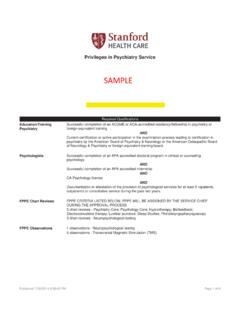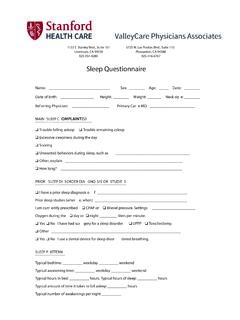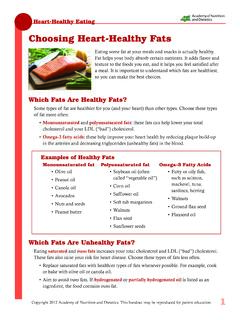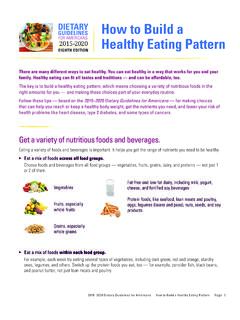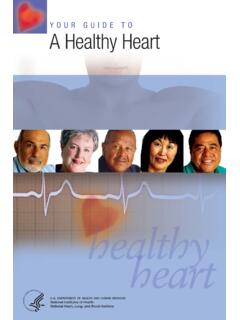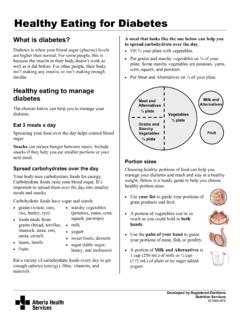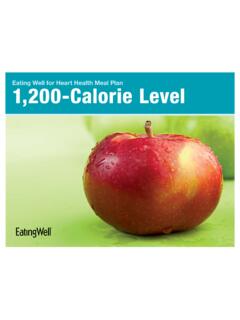Transcription of Heart Healthy Eating Nutrition Therapy - Stanford Health Care
1 Client Name _____ Date _____. RD/DTR _____. Email _____ Phone _____. Heart Healthy Eating Nutrition Therapy Ways to Reduce Cholesterol Limit saturated fats and trans fats: o Foods high in saturated fats include fatty meat, poultry skin, bacon, sausage, whole milk, cream, and butter. o Trans fats are found in stick margarine, shortening, some fried foods, and packaged foods made with hydrogenated oils. o Instead of butter or stick margarine, try reduced-fat, whipped, or liquid spreads. Limit the amount of cholesterol that you eat to less than 200 milligrams (mg) per day.
2 O Foods high in cholesterol include egg yolks (one egg yolk has about 212 mg of cholesterol), fatty meat, whole milk, cheese, shrimp, lobster, and crab. Limit the amount of sodium that you eat to less than 2,000 milligrams (mg) per day. o It is good to select foods with no more than 140 mg per serving. o Foods with more than 300 mg sodium per serving may not fit into a reduced-sodium meal plan. o Remember to check serving sizes on the label. If you eat more than one serving, you will get more sodium than the amount listed. o Use caution when you eat outside of your home.
3 Restaurant foods can be high in sodium, and you cannot always get information about this. Limit the total amount of fat that you eat (including Heart - Healthy fats) to 25% to 35%. of the calories that you eat. If you should eat 2,000 calories per day, your fat intake can be between 50 grams (g) and 75 g per day. Eat more omega-3 fats ( Heart - Healthy fats): o Good choices include salmon, tuna, mackerel, and sardines. Aim to eat fish twice a week. o Other foods with omega-3 fats include walnuts and canola and soybean oils. o Flaxseed is another source of omega-3 fats.
4 Have it as flaxseed oil or ground flaxseed. Get 20 g to 30 g of dietary fiber per day: o Fruits, vegetables, whole grains, and dried beans are good sources of fiber: Aim for 5 cups of fruits and vegetables per day. Have 3 ounces (oz) of whole grain foods every day. Plan to eat more plant-based meals, using beans and soy foods for protein. Talk with your dietitian or doctor about what a Healthy weight is for you. Set goals to reach and maintain that weight. Talk with your Health care team to find out what types of physical activity are best for you. Set a plan to get about 30 minutes of exercise on most days.
5 Copyright American Dietetic Association. This handout may be duplicated for client education. Heart Healthy Eating Nutrition Therapy Page 1. Ways to Reduce Sodium A low-sodium (salt) diet may help prevent build up of extra water in your body. This may be for high blood pressure, Heart failure, kidney disease or other conditions in which swelling or fluid retention can occur. Even if you take a pill for blood pressure or a water pill (diuretic) to remove fluid, it is still important to have less salt in your diet. If you follow this diet strictly and avoid processed foods, the sodium content will be about 1500 mg/day.
6 This will allow you to have about 1/8 tsp table salt to season your food. Use lite salt and you may have tsp. You should usually avoid these items: Salt teaspoon of table salt has almost 600 milligrams sodium. Processed foods salt is added in large amounts to some regular foods. Examples are: o canned foods soups, stews, sauces, gravy mixes, and some vegetables o frozen foods dinners, entrees, vegetables with sauces o snack foods salted chips, popcorn, pretzels, pork rinds and crackers o packaged starchy foods seasoned noodle or rice dishes, stuffing mix, macaroni and cheese dinner o instant cooking foods to which you add hot water and stir potatoes, cereals, noodles, rice, etc.
7 O Mixes cornbread, biscuit, cake, pudding o meats and cheeses deli or lunch meats bologna, ham, turkey, roast beef, etc. cured or smoked meats corned beef, sausage of any kind (patty, link, Kielbasa, Italian, wieners or hot dogs), bacon canned meats potted meats, spreads, Spam , Vienna sausage, etc. cheeses read labels and avoid those with more than 140 mg sodium per serving; examples are American cheese, Velveeta , Cheez Whiz , etc. Condiments, Sauces and Seasonings o mustard, ketchup, salad dressings, bouillon cubes or granules o sauces Worcestershire, barbecue, pizza, chili, steak, soy or horseradish sauce o meat tenderizer, monosodium glutamate o any seasoning that has salt in the name or on the label.
8 Avoid celery salt, garlic salt and onion salt; however, it is okay to have garlic or onion powder or flakes read labels carefully lemon pepper often has salt o pickles and olives Copyright American Dietetic Association. This handout may be duplicated for client education. Heart Healthy Eating Nutrition Therapy Page 2. What can you use to season your food? Tart flavor try lemon or lime juice, vinegar Hot flavor peppers are low in sodium; hot sauce has salt, but if you use just a drop or two it will not add up to much Herbs and spices onions, garlic, salt-free seasonings like Mrs.
9 Dash . Recommended Foods Food Groups Recommended Foods Milk 2 servings a day. 1 serving has about 150 milligrams (mg). Nonfat (skim), low-fat, or 1% fat milk Nonfat or low-fat yogurt Fat-free and low-fat cheese with less than 150 milligrams sodium per serving Hard cheese, such as low-fat cheddar or mozzarella Low-fat cottage cheese - cup washed under cold water in a sieve to remove most of the sodium Meat and Other 3 servings a day. 1 serving has about 60 mg. Protein Foods Lean cuts of beef and pork (loin, leg, round, extra lean hamburger), skinless poultry, fish (3 oz cooked meat).
10 Venison and other wild game Dried beans and peas Nuts and nut butters Egg whites or egg substitute Read all meat labels! Many raw meats now have added broth with sodium salts that make the meat hold moisture and taste juicy and tender. Choose a product with less than 5% of the DV for sodium. Fruits and 5 or more servings a day. 1 serving has only about 10 mg. Vegetables Fresh, frozen, or canned vegetables without added fat or salt Tomato or vegetable juice, canned, without salt Tomatoes, tomato sauce, canned,without salt Fresh, frozen canned, or dried fruit Fruit juices Grains 5 servings a day.





